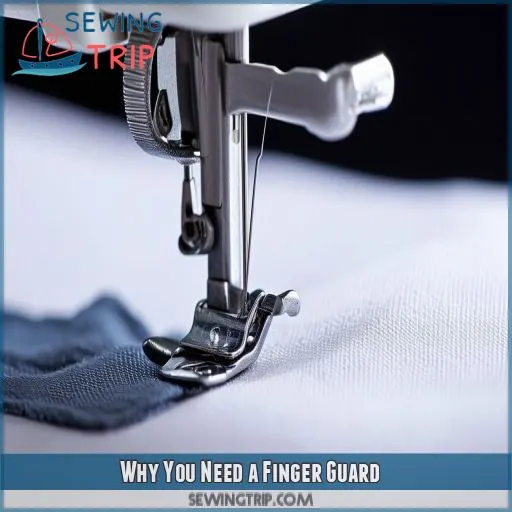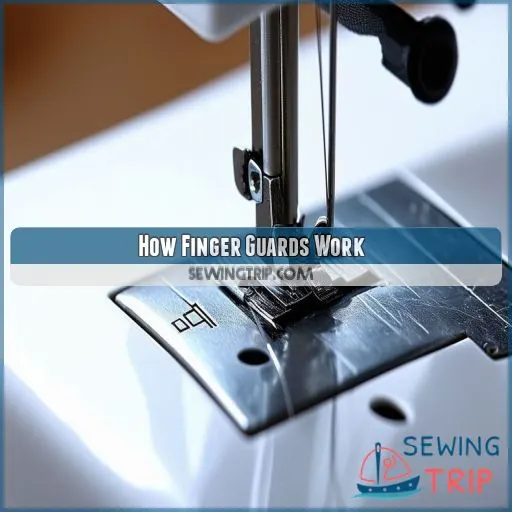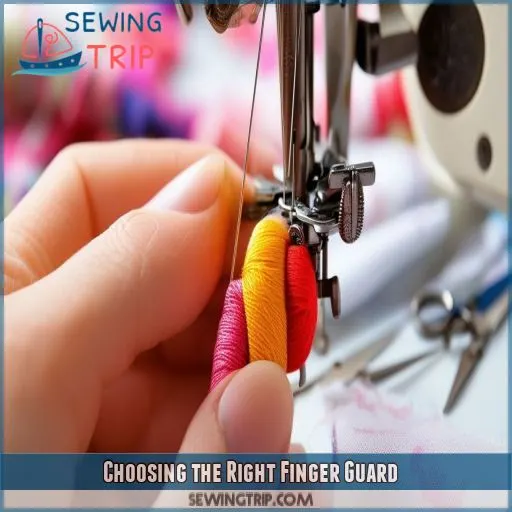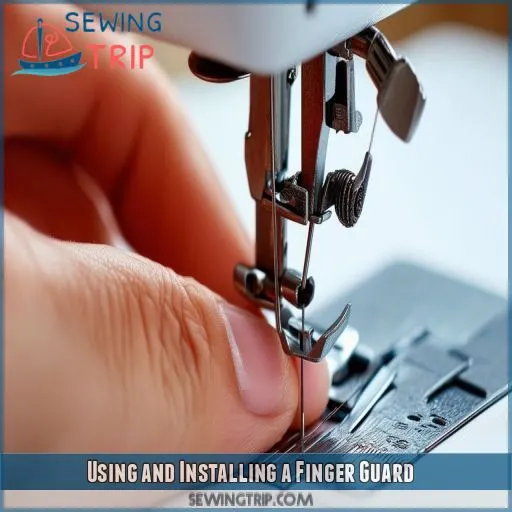This site is supported by our readers. We may earn a commission, at no cost to you, if you purchase through links.
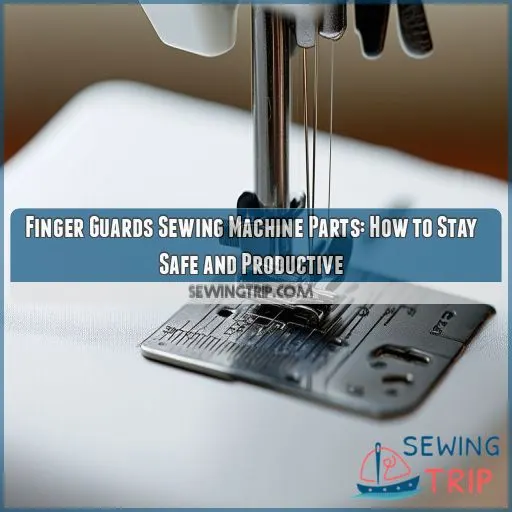
These handy tools are made from plastic or metal and fit securely over the needle clamp screw. They’re compatible with various sewing machine brands like Brother, Singer, and Juki.
If you’re a beginner, a finger guard is a must-have. It lets you focus on mastering those sewing skills without the worry of needle-related injuries. Plus, they’re affordable and easy to install.
Keep reading to learn more about choosing, using, and benefiting from these handy sewing accessories.
Table Of Contents
Key Takeaways
- Sewing machines can be your BFF, but those needles are sharp. One slip and you’re dealing with an accidental prick. Ouch! That’s why finger guards are a must-have. They’re like a protective shield, keeping your fingers safe and giving you peace of mind.
- Finger guards are compatible with various sewing machine brands like Brother, Singer, and Juki. They’re easy to install, affordable, and offer protection for sewing newbies. No more needle-related injuries or painful pricks that might scare you away from sewing forever.
- These guards are made of plastic or metal, offering lightweight protection or sturdy shielding. They fit securely over the needle clamp screw, acting as a barrier between your fingers and the needle. It’s like having a trusty sidekick for your sewing adventures.
- You can sew with confidence, knowing your fingers are guarded. No more worries about accidental punctures or needle-related injuries. It’s like taking a stroll through a meadow without the fear of stumbling upon a bee’s nest. Sewing with a guard is smooth and stress-free, letting you focus on your craft.
Why You Need a Finger Guard
Whether you’re a sewing novice or a pro, keeping your fingers safe from the needle is a must. Finger guards are a simple yet effective solution, offering protection and peace of mind.
Preventing Accidental Punctures
Sewing machines pack a punch, and their needles can easily puncture your skin, causing pain and trouble. Ouch!
That’s where finger guards come in – they’re like a knight in shining armor, creating a barrier between your fingers and the needle.
No more accidental pricks!
These guards are typically made of plastic or metal and fit snugly over the needle clamp screw on the pressure foot.
A small price to pay for peace of mind and safety.
Importance for Beginners
As a beginner, you’ll want to focus on mastering the basics of sewing.
Not worrying about needle pricks and injuries is key.
That’s where a finger guard comes in – it’s like having a trusty sidekick that keeps your fingers safe from the needle’s path.
No more accidental pricks or painful moments that might make you want to put down the sewing machine for good.
Compatibility With Various Machines
You can find finger guards that are compatible with a range of sewing machine brands and models. Here are some options:
- Brother ST531HD Strong & Tough 53 Stitch Sewing Machine: This machine comes with a built-in finger guard and has received positive reviews online.
- YICBOR 6-piece set: Compatible with Singer, Brother, Juki, Consew, and Yamata sewing machines.
- VANELY 6-piece set: Also compatible with Singer, Brother, Juki, Consew, and Yamata machines.
- CKPSMS Brand #KP-19240: Compatible with JUKI, Brother, and CONSEW industrial single-needle machines.
If you’re unsure about compatibility, you can always check with the manufacturer of your sewing machine. They may offer a finger guard that’s specifically designed for your machine model.
Affordable Investment for Safety
You know the old saying, "An ounce of prevention is worth a pound of cure."
Well, that definitely applies here.
A finger guard is a small investment that offers a big payoff in safety.
It’s like an insurance policy for your fingers.
For just a few bucks, you can save yourself from the pain and hassle of a needle injury.
That’s a pretty good deal, right?
How Finger Guards Work
Now that you know why finger guards are essential, let’s talk about how they work. These guards are designed to create a protective barrier between your fingers and the needle, preventing accidental punctures. They’re made of plastic or metal and fit snugly over the needle clamp screw on the pressure foot.
Materials Used (Plastic or Metal)
Finger guards are usually made of plastic or metal. Each material has its pros:
- Plastic guards are lightweight and easy to move around.
- Metal guards give you the most protection and they last a long time.
Whether you choose plastic or metal depends on what you like and what you need for sewing. Both options keep your fingers safe, so you can focus on your creative projects without worrying.
Fitting Over the Needle Clamp Screw
Fitting your finger guard is a simple and secure process. Here’s a step-by-step guide:
| Step | Description |
|---|---|
| 1 | Loosen the thumbscrew on the presser foot. |
| 2 | Slide the finger guard over the needle clamp screw. |
| 3 | Tighten the thumbscrew to secure the guard in place. |
| 4 | Adjust the position of the guard to make sure it lines up with the needle. |
Creating a Barrier Between Fingers and Needle
Finger guards are a simple yet effective solution to protect your fingers from the needle.
Whether you’re a beginner or an experienced sewist, these guards create a barrier, keeping your fingers safely away from the needle.
It’s like having a protective shield that gives you peace of mind and lets you focus on your sewing projects without worrying about accidental punctures.
Curved or Rigid Designs for Smooth Fabric Movement
When it comes to finger guards, you’ve got options:
- Curved designs: These are perfect for smooth fabric movement, allowing your fabric to glide effortlessly as you sew.
- Rigid designs: If extra protection is what you’re after, these guards provide a sturdy barrier between your fingers and the needle.
- A combination of both: Why not have the best of both worlds? Some finger guards offer a hybrid design, giving you the smoothness of a curved guard and the added security of a rigid one.
Choosing the Right Finger Guard
When choosing a finger guard, it’s important to think about a few key factors to make sure it fits right and works well. You’ll want to pay attention to the size and shape of your machine’s needle clamp screw, going for a snug and secure fit.
Considering Machine’s Needle Clamp Screw Size
When picking a finger guard, it’s important to think about the size of your machine’s needle clamp screw. A good fit keeps you safe and prevents accidents. Here’s a table to guide you:
| Screw Size | Fit | Brands |
|---|---|---|
| Standard | Most machines | Universal fit |
| Small | Older/compact machines | Singer, Brother |
| Large | Industrial/specialty machines | Juki, Bernina |
| Custom | Unique screw sizes | Check manufacturer |
Make sure to measure your screw before buying a finger guard.
Looking for a Snug and Secure Fit
When choosing a finger guard, a snug and secure fit is essential. You want it to feel like a comfortable glove, not a loose sock.
Ensure it fits nicely over your machine’s needle clamp screw. A secure fit means no slipping or sliding, keeping your fingers safe from the needle’s path.
Durable Materials for Repeated Use
For durability, you want a finger guard that can take a beating. Look for guards made from sturdy stuff like metal or hard plastic. These materials are built to last, ensuring your fingers stay safe stitch after stitch.
Additional Features (Thread Cutter or Stitching Guide)
When choosing a finger guard, consider additional features like a thread cutter or stitching guide. These features can enhance your sewing experience and productivity.
- Thread Cutter: This feature allows you to quickly and easily cut threads, saving you time and effort. No more searching for scissors or struggling with tangled threads.
- Stitching Guide: A stitching guide provides a visual reference for accurate and consistent stitching. It helps you maintain straight lines and even stitching lengths, improving the overall quality of your sewing projects.
These extra features can make your sewing projects more enjoyable and efficient, so be sure to look out for them when selecting a finger guard.
Using and Installing a Finger Guard
Now that you know all about finger guards and why they’re a must-have, let’s get into the nitty-gritty of using and installing one. This is where you’ll learn how to make the most of this handy sewing accessory and keep your fingers safe.
Sliding Over the Needle Clamp Screw
To install a finger guard, start by loosening the thumbscrew on your presser foot. Then, simply slide the finger guard over the needle clamp screw. It’s a snug fit, so make sure it’s securely in place. You don’t want it sliding around while you sew.
Ensuring a Secure Fit Before Sewing
Now that you’ve slid the finger guard over the needle clamp screw, it’s time to make sure it’s tight. You don’t want it moving around or coming loose while you’re sewing up a storm.
Give it a gentle tug to make sure it’s snug and secure. You don’t want any wiggle room or unexpected surprises mid-project.
It’s like making sure your shoes are tied before a big race. You don’t want to trip and fall, and with sewing, you don’t want any mishaps that could’ve been avoided with a quick check.
Removing the Guard Carefully
When it’s time to remove the finger guard, exercise caution to avoid damage and keep yourself safe:
- Unfasten the thumbscrew carefully, without applying excessive force.
- Gently slide the guard off the needle clamp screw.
- Store it safely until you’re ready to sew again.
- Remember to reinstall the guard securely before your next sewing session.
Replacing the Guard After Sewing
Always remember to replace the finger guard after sewing.
It’s a simple step, but it’s really important for your safety.
Think of it as your needle protection buddy, ready to guard your fingers against any accidental punctures.
Before you start sewing, make sure that little buddy is securely in place, giving you peace of mind to focus on your creative projects.
Benefits and Compatibility of Finger Guards
Finger guards are a simple yet effective solution to protect your fingers from accidental needle pricks. They’re easy to install and provide peace of mind, letting you focus on your sewing projects without worrying about injuries.
Safety and Peace of Mind
A finger guard is your protective sidekick, giving you the confidence to sew without worrying about needle-related injuries.
It’s like having a personal bodyguard for your fingers!
This simple yet effective accessory creates a barrier between your fingers and the needle, offering peace of mind and a stress-free sewing experience.
You can focus on your craft, knowing you’re protected from accidental punctures.
Increased Productivity and Versatility
With a finger guard, you can sew with confidence and for longer periods without worrying about taking breaks due to accidental pricks. This simple accessory boosts your efficiency and accuracy, helping you power through projects with speed and control. It’s like having an extra layer of protection that enhances your overall sewing experience.
Affordability and Compatibility With Various Machines
Finger guards are a worthwhile investment, offering peace of mind and protection without breaking the bank. They’re an essential tool for beginners, and their compatibility with various machines makes them accessible to all. Sewing machine safety doesn’t have to be costly!
Regular Cleaning and Maintenance
Keeping your finger guard clean is essential for maintaining its effectiveness and longevity. Over time, lint and debris can build up, impacting its performance. Make it a habit to regularly clean your finger guard to prevent any gunk from accumulating and keep it working well.
Frequently Asked Questions (FAQs)
How to protect fingers from sewing machines?
You can protect your fingers from sewing machines by using a needle guard. These guards fit over the needle clamp screw, creating a barrier to prevent accidental punctures. They’re easy to install and offer peace of mind while sewing.
How to put a finger guard on a sewing machine?
Loosen the thumbscrew, slide the guard over the presser foot, tighten the thumbscrew, and align it with the needle.
What do you wear to protect your finger while sewing?
Thimbles are a popular choice to protect your fingers while sewing. They come in different sizes and materials, like metal or leather, and can be worn on the middle finger, thumb, or forefinger. You can also try finger gloves or "corn" pads.
What do you use to prevent your fingers from picking while sewing?
Keep your eYes on the prize and your fingers safe with a needle guard. A simple, low-cost solution to protect your fingers from accidental punctures. No more picking. No more pricking. Just smooth sewing and peace of mind.
How often should I replace my finger guard?
Replace your finger guard when it’s worn out. Sewing machine finger guards are inexpensive, so it’s easy to replace them when you need to.
Can I sew without a finger guard?
Yes, you can sew without a finger guard, but it’s not recommended. Finger guards are especially useful for beginners and young people learning to sew, adding a layer of protection and peace of mind.
Are finger guards universal?
No, finger guards aren’t universal. You need to check the product description or contact the manufacturer to see if a specific model is compatible with your sewing machine.
Can I use a finger guard with my embroidery machine?
Yes, you can use a finger guard with an embroidery machine. Finger guards are compatible with all kinds of sewing machines. Just make sure it doesn’t interfere with the fabric as it’s fed through the machine.
What happens if I dont use a finger guard?
You might be wondering, "What’s the worst that could happen without a finger guard?" Well, imagine taking a stroll through a beautiful meadow, humming a happy tune, when suddenly—ouch! You’ve stumbled upon a bee’s nest and gotten stung. Now, swap that bee sting for a needle prick. Not fun, right?
Conclusion
So, there you have it. Finger guards are like a knight in shining armor, protecting your fingers from the dragon’s needle. They’re easy to install, affordable, and compatible with most machines. With a finger guard, you can sew with confidence, knowing your fingers are safe from accidental pricks. No more needle-related injuries or costly trips to the ER. Just smooth sewing and peace of mind.
Now go forth, guard those fingers, and stitch like a pro!

